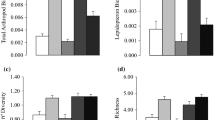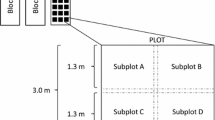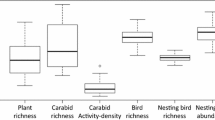Abstract
We studied the disturbance associated with prairie vole burrows and its effects on grassland plant diversity at the patch (1 m2) and metacommunity (>5 ha) scales. We expected vole burrows to increase patch-scale plant species diversity by locally reducing competition for resources or creating niche opportunities that increase the presence of fugitive species. At the metacommunity scale, we expected burrows to increase resource heterogeneity and have a community composition distinct from the matrix. We measured resource variables and plant community composition in 30 paired plots representing disturbed burrows and undisturbed matrix patches in a cool-season grassland. Vole disturbance affected the mean values of nine resource variables measured and contributed more to resource heterogeneity in the metacommunity than matrix plots. Disturbance increased local plant species richness, metacommunity evenness, and the presence and abundance of fugitive species. To learn more about the contribution of burrow and matrix habitats to metacommunity diversity, we compared community similarity among burrow and matrix plots. Using Sorenson’s similarity index, which considers only presence–absence data, we found no difference in community similarity among burrows and matrix plots. Using a proportional similarity index, which considers both presence–absence and relative abundance data, we found low community similarity among burrows. Burrows appeared to shift the identity of dominant species away from the species dominant in the matrix. They also allowed subordinate species to persist in higher abundances. The patterns we observed are consistent with several diversity-maintaining mechanisms, including a successional mosaic and alternative successional trajectories. We also found evidence that prairie voles may be ecosystem engineers.

Similar content being viewed by others
References
Baskin CC, Baskin JM (1998) Seeds: ecology, biogeography, and evolution of dormancy and germination. Academic, San Diego, CA
Bazzaz FA (1996) Plants in changing environments: linking physiological, population, and community ecology. University of Cambridge Press, Cambridge, UK
Bee JW, Glass GE, Hoffman RS, Patterson RR (1981) Mammals in Kansas. University of Kansas, Lawrence, KS
Bradshaw L, Goldberg DE (1989) Resource levels in undisturbed vegetation and mole mounds in old fields. Am Midl Nat 121:176–783
Buyanovsky GA, Kucera CL, Wagner GH (1987) Comparative analyses of carbon dynamics in native and cultivated ecosystems. Ecology 68:2023–2031
Canals RM, Herman DJ, Firestone MK (2003) How disturbance by fossorial mammals alters N cycling in a California annual grassland. Ecology 84:875–881
Chao A, Chazdon RL, Colwell RK, Shen T-J (2005) A new statistical approach for assessing similarity of species composition with incidence and abundance data. Ecol Lett 8:148–159
Chesson P, Huntly N (1997) The roles of harsh and fluctuating conditions in the dynamics of ecological communities. Am Nat 150:519–553
Cole FR, Batzli GO (1978) Influence of supplemental feeding on a vole population. J Mammal 59:809–819
Colwell RK (2005) EstimateS v.7.5: statistical estimation of species richness and shared species from samples. http://viceroy.eeb.uconn.edu/EstimateS. Cited 27th March 2007
Connell JH (1978) Diversity in tropical rain forests and coral reefs: high diversity of trees and corals is maintained only in a nonequilibrium state. Science 199:1302–1310
Davis WH, Kalisz PJ (1992) Burrow systems of the prairie vole, Microtus ochrogaster, in central Kentucky. J Mammal 73:582–585
Dickey HP, Zimmerman JL, Plinsky RO, Davis RD (1977) Soil survey of Douglas County, Kansas. Soil Conservation Service (now the NRCS), United States Department of Agriculture, Washington, DC
Fehmi JS, Bartolome JW (2002) Species richness and california voles in an annual and a perennial grassland. West N Am Nat 62:73–81
Getz LL (1985) Habitats. In: Tamarin RH (ed) Biology of new world Microtus (Spec. Publ. No. 8). The American Society of Mammalogists, Provo, UT, pp 286–309
Getz LL, Gudermuth DF, Benson SM (1992) Pattern of nest occupancy of the prairie vole Microtus ochrogaster in different habitats. Am Midl Nat 128:197–202
Getz LL, Hofmann JE, McGuire B, Dolan III TW (2001) Twenty-five years of population fluctuations of Microtus ochrogaster and M. pennsylvanicus in three habitats in east-central Illinois. J Mammal 82:22–34
Gibson DJ (1989) Effects of animal disturbance on tallgrass prairie vegetation. Am Midl Nat 121:144–154
Glenn-Lewin DC, Johnson LA, Jurik TW, Akey A, Leoschke M, Rosburg T (1990) Fire in Central North American grasslands: vegetative reproduction, seed germination, and seedling establishment. In: Collins SL, Wallace LL (eds) Fire in North American tallgrass prairies. University of Okalhoma Press, Norman, OK, pp 28–45
Grubb PJ (1977) The maintenance of species-richness in plant communities: the importance of the regeneration niche. Biol Rev 52:107–145
Hobbs RJ, Huenneke LF (1992) Disturbance, diversity, and invasion: implications for conservation. Conserv Biol 6:324–337
Howe HF, Brown JS (2001) The ghost of granivory past. Ecol Lett 4:371–378
Howe HF, Brown JS, Zorn-Arnold B (2002) A rodent plague on prairie diversity. Ecol Lett 5:30–36
Huntly N, Inouye R (1988) Pocket gophers in ecosystems: patterns and mechanisms. Bioscience 38:786–793
Huston MA (1979) A general hypothesis of species diversity. Am Nat 113:81–101
Huston MA (1994) Biological diversity: the coexistence of species on changing landscapes. Cambridge University Press, Cambridge, UK
Hutchinson GE (1951) Copepodology for the ornithologist. Ecology 32:571–577
Inouye RS, Huntly NJ, Tilman D, Tester JR (1987) Pocket gophers (Geomys bursarius), vegetation, and soil nitrogen along a successional sere in east central Minnesota. Oecologia 72:178–184
Jameson EW (1947) Natural history of the prairie vole (mammalian genus Microtus). Univ Kansas Nat Hist Mus 1:125–151
Jog S, Kindscher K, Questad EJ, Foster B, Loring H (2006) Floristic quality as an indicator of native species diversity in managed grasslands. Nat Areas J 26:149–167
Kalisz PJ, Davis WH (1992) Effect of prairie voles on vegetation and soils in central Kentucky. Am Midl Nat 127:392–399
Lennon JJ, Koleff P, Greenwood JJD, Gaston KJ (2001) The geographical structure of British bird distributions: diversity, spatial turnover and scale. J Anim Ecol 70:966–979
Lin YK, Keane B, Isenhour A, Solomon NG (2006) Effects of patch quality on dispersal and social organization of prairie voles: an experimental approach. J Mammal 87:446–453
Loreau M, Mouqet N, Holt RD (2003) Meta-ecosystems: a theoretical framework for a spatial ecosystem ecology. Ecol Lett 6:673–679
Loreau M, Mouqet N, Holt RD (2005) From metacommunities to metaecosystems. In: Holyoak M, Leibold MA, Holt RD (eds) Metacommunities: spatial dynamics and ecological communities. University of Chicago Press, Chicago, IL, pp 418–438
Lupwayi NZ, Clayton GW, O’Donovan JT, Harker KN, Turkington TK, Rice WA (2004) Soil microbiological properties during decomposition of crop residues under conventional and zero tillage. Can J Soil Sci 84:411–419
Magurran AE (2004) Measuring biological diversity. Blackwell, Oxford, UK
Mankin PC, Getz LL (1994) Burrow morphology as related to social organization of Microtus ochrogaster. J Mammal 75:492–499
Menhusen BR (1963) An investigation on the food habits of four species of rodents in captivity. Trans Kans Acad Sci 66:107–112
Pascarella JB, Gaines MS (1991) Feeding preferences of the prairie vole (Microtus ochrogaster) for seeds and plants from an old-field successional community. Trans Kans Acad Sci 94:3–11
Pielou EC (1977) Mathematical ecology. Wiley, New York
Platt WJ (1975) The colonization and formation of equilibrium plant species associations on badger disturbances in a tall-grass prairie. Ecol Monogr 45:285–305
Platt WJ, Connell JH (2003) Natural disturbances and directional replacement of species. Ecol Monogr 73:507–522
Reichman OJ, Seabloom EW (2002a) Ecosystem engineering: a trivialized concept? Response. Trends Ecol Evol 17:308
Reichman OJ, Seabloom EW (2002b) The role of pocket gophers as subterranean ecosystem engineers. Trends Ecol Evol 17:44–49
Seabloom EW, Richards SA (2003) Multiple stable equilibria in grasslands mediated by herbivore population dynamics and foraging behavior. Ecology 84:2891–2904
Sokal RR, Rohlf FJ (1995) Biometry, 3rd edn. W.H. Freeman and Co, San Francisco, CA
Sousa WP (1979) Disturbance in marine intertidal boulder fields: the nonequilibrium maintenance of species diversity. Ecology 60:1225–1239
Squiers ER (1989) The effects of seasonal timing of disturbance on species composition in a first-year oldfield. J Torrey Bot Soc 116:356–363
Tilman D (1983) Plant succession and gopher disturbance along an experimental gradient. Oecologia 60:285–292
Acknowledgments
We thank the National Science Foundation (DEB 01-08302 and the Graduate Research Fellowship Program), the USDA-NRICGP (2003-35101-12934), and KSR for funding. We appreciate the help of the KSR staff, Nathan Olds, and Andrea Wolf. We also thank D. Fautin, T. Aschenbach, C. Collins, T. Dickson, I. Khavin, and C. Murphy for helpful comments. Two anonymous reviewers and J. Silander provided comments that greatly improved the manuscript. All measurements reported comply with laws of the United States.
Author information
Authors and Affiliations
Corresponding author
Additional information
Communicated by John Silander.
Rights and permissions
About this article
Cite this article
Questad, E.J., Foster, B.L. Vole disturbances and plant diversity in a grassland metacommunity. Oecologia 153, 341–351 (2007). https://doi.org/10.1007/s00442-007-0734-y
Received:
Accepted:
Published:
Issue Date:
DOI: https://doi.org/10.1007/s00442-007-0734-y




